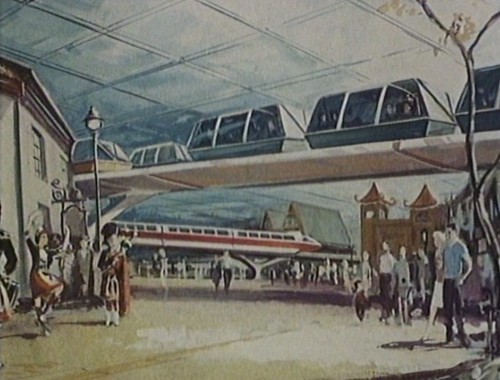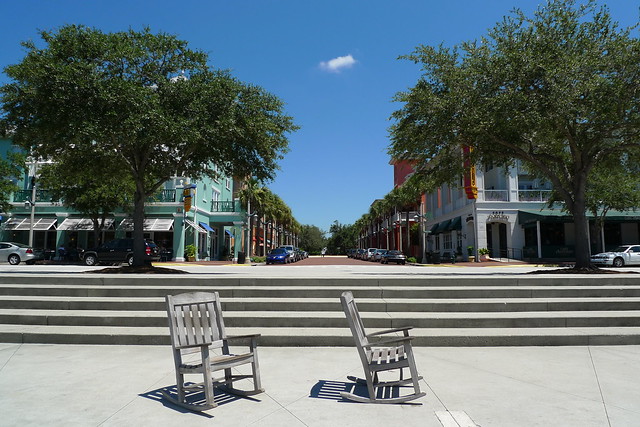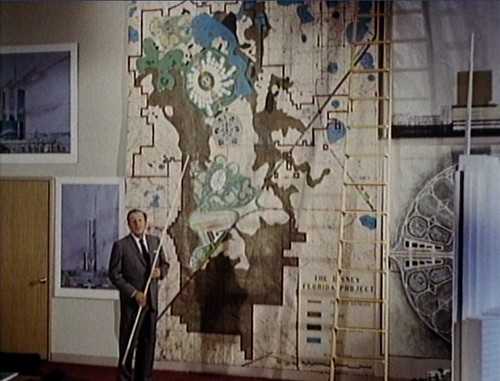In my recent post about Walt Disney’s knack for urban design, I alluded to the comparative disappointment of Disney World, the Florida Disney park brought to completion without Walt Disney’s involvement (the park opened in 1971, while Walt Disney had died in 1966). Yet I didn’t really get into the full scale of that disappointment. Disney World, as Walt Disney envisaged it, was intended to be a far grander and more ambitious project than it ultimately became. Rather than a network of theme parks and resorts, the Florida property was envisaged as a giant complex featuring not just a theme park and resorts but also an airport, industrial park and – most interestingly – a planned city known as EPCOT (for Experimental Prototype Community of Tomorrow).
The city wasn’t an afterthought: it was actually the most important element of the project in Disney’s mind. In a film prepared in 1966 to brief Florida legislature on the project, Disney emphasised EPCOT’s importance:
I don’t believe there’s a challenge anywhere in the world that’s more important to people everywhere than finding solutions to the problems of our cities. But where do we begin? How do we start answering this great challenge? Well, we’re convinced we must start with the public need. And the need is not just for curing the old ills of old cities. We think the need is for starting from scratch on virgin land and building a special type of new community.
This interest in urban planning did not come from nowhere: Disney’s interest had been growing for some time. From the late 1940s onwards, as his interest in animation waned, Disney’s principal creative output had become his contribution to the physical environment. Disneyland was, of course, the most obvious example, but this interest manifested itself in numerous sphere of his life. At a small scale, in his domestic sphere, he became immersed in the construction of elaborate model railways in his home. He had also turned his mind to the effect of the physical environment on creative endeavour when he planned his new studio in Burbank in the late 1930s and then, later, through his involvement in the planning of a campus for the newly-formed California Institute of the Arts in the early 1960s. He dabbled in property development with the proposed (but never built) Mineral Kings ski resort in Southern California, and with an urban renewal project in his plans to redevelop a two block area of riverfront in St. Louis. In the immediate aftermath of the Disneyland project, he spun off the work on its attractions and people movement systems into design work on several World’s Fairs, as well as monorail and “People Mover” designs of potentially wider application.
EPCOT became a logical end-point for all those endeavours. Throughout the last years of his life he and his design team were absorbed in urban planning theory, studying various existing concepts for idealised cities: Ebenezer Howard’s Garden City; Le Corbusier’s Radiant City; Victor Gruen’s Metropolis of Tomorrow from his book The Heart of Our Cities; Clarence Perry’s neighbourhood unit plan for New York City; Clarence Stein and Henry Wright’s pedestrian oriented plan for Radburn, New Jersey; British New Towns (including the still-emerging plans and governance models for Milton Keynes); and various American company towns and planned communities. Disney’s team weren’t planning a half-baked theme park with a residential quarter, or even some Jetson-ish inhabited version of Tomorrowland: they were looking at what was then the state-of-the-art in urban planning theory, and trying to synthesise it into some kind of workable whole. What’s more, unlike so many utopians, Disney was keenly oriented towards implementation. He was not dependent on some other benefactor or developer: he was to be the developer, and got as far as purchasing the land.
EPCOT is therefore worthy of study as one of the most interesting and progressed model city concepts of the twentieth century. For a long time this recognition was hampered by the fact that EPCOT’s plans remained obscured by the Disney Corporation, which doesn’t have an interest in highlighting the dramatic discord between what was planned in Florida and what was ultimately built. Yet there are invaluable sources that give a sense of what Disney intended, most notably Steve Mannheim’s book Walt Disney and the Quest for Community. And there’s also the aforementioned film for the Florida legislature, which is embedded below (in three parts), and is the best publicly available document outlining what Disney envisaged EPCOT to be. (You can get this film on DVD as part of the Disney Treasures: Tomorrowland DVD).
So what to make of all this? Just how do we rate Disney’s urban vision as a concept?
We should start by acknowledging that it’s very, very easy to pick holes in any concept for utopian planned cities. Such an exercise is always driven, at some level, by a wistful vision of a better world, and this kind of idealism will always be vulnerable to attack. The inevitable unpleasant realities of life – crime, poverty, social conflict – will always appear and can be claimed as demonstrations of the wrongheadedness of the whole concept. Those who disavow utopianism don’t eliminate such problems either, of course, but they can take the intellectual high ground by claiming that at least they don’t deny such realities. Someone like Disney, with his background in film fantasy and theme park construction, is especially ripe for critique as a deluded fantasist.

And, of course, the track record for utopian planning is not good. Le Corbusier’s influence, in particular, did astonishing damage: outside of political figures and dictators, it is hard to find a figure so nutty and misguided who was so widely taken seriously, and to such devastating effect. Quasi-Le Corbusierian urban renewal – tearing down established inner city neighbourhoods and replacing them with soulless high rise buildings – was paired with massive car-oriented suburban expansion to form the default template for urban planning after World War II. Our exposure over that time to countless soulless post-war housing estates – both inner city high rises and suburban tracts – has given us an instinctive understanding of the way in which dreams of a better city tend to grey out into a more disappointing reality.
Disney’s city stands in a strange double-sided relationship with that planning orthodoxy. EPCOT was in one sense a rejection of what typical cities had become. At Disneyland he created an urban environment that stood as both an escape from and rebuke of post-war Los Angeles; now he wanted to create a more complete solution. Note that his own description set EPCOT up not just as an alternative to then–unpopular inner city areas (“the old ills of old cities”), but also as a new approach for “starting from scratch on virgin land.” This underlines Disney’s rejection of the then-prevailing suburban model of city building. Yet at the same time, EPCOT drew heavily on the same impulses and planning that had driven that status quo.
So, for example, there is a lot of Le Corbusier’s Radiant City in the description of EPCOT’s central city. The fantasy of the perpetually free-flowing freeway network is pure Corbu, as is the vision of freeing up swathes of pedestrian space within the centre. This vision is then bolted on to a vision of the outer residential areas that is more inspired by Ebenezer Howard, who had persuasively articulated the basic suburban dream of living enjoying the best of both worlds: “town-country,” as Howard put it. The idea of linking a series of new towns over a larger metropolis is also part of Disney’s debt to Howard (in this case filtered via Victor Gruen).
Many of the criticisms that can be made of Disney’s city are therefore the same as those that could be made of these more established theorists. So, for example, EPCOT echoes some of the misplaced faith in grand, highly engineered technical solutions, which in retrospect tend to come off looking ridiculous: Le Corbusier had his airport runways nestled between skyscrapers, while Disney had his giant air-conditioned dome (though it must be said this seems less crazy to anyone who has actually been exposed to Florida’s climate). The obvious hazard for the inner city portion of EPCOT would have been the fate that befell most Corbusierian urban renewal projects: for all the visions in marketing drawings of plazas full of people, their open spaces were usually soulless and vastly less cosmopolitan than established inner city areas. A similar fear could be held for the outer areas of EPCOT: that they would be empty and lifeless during the day, replicating the classic problems with conventional suburban estates (albeit with a better landscape treatment and less reliance on cars).

There is validity in all these criticisms. Any utopian or quasi-utopian plan will, if ever realised, fall short of its ideals at some point, and these would have been amongst the legitimate danger points for Disney’s plan. Yet Disney was relatively well placed to head off some of these concerns. For example, Disney’s knack for urban design (the subject of my previous post) suggests he would have been more likely than most to activate and populate his urban spaces. Corbusierian open spaces tended to fail because the design resolution was so lousy, inheriting Le Corbusier’s distaste for the disorder of traditional towns and thereby rejecting all that was good about established urban spaces in favour of sterile grandeur. Yet fine grain and design detail was something Disney was particularly good at: while he never progressed to EPCOT’s detailed design, it is hard to imagine him presiding over the kind of design approaches that dogged Corbuserian urban renewal projects.
The suburban quarter, too, would have at least been distinguished from conventional suburbs by its limited size. While the intended dimensions of the town are a little obscure, it certainly wouldn’t have been as expansive or relentlessly single use as conventional post-war residential subdivision. The proximity of that town centre, and the focus on providing transport alternatives to the car, suggest Disney had learnt two of the principal lessons of suburbia: that obsessively separating uses is not a great idea, and that planning only for the car is disastrous. Just as Disneyland provides a good working example of Disney’s knack for designing civic space, so too it inspires confidence that Disney was serious about the provision of extensive public transportation. It is difficult to overstate Walt Disney’s enthusiasm for transport systems, and Disneyland is almost comically overstuffed with various different transportation options. The park is notable for how successfully and efficiently its systems run, and how successful it is in making people enjoy the experience of being moved from place to place. Disney is distinguished from most comparable utopian planners by his track record in successfully implementing complex projects.
I should make it clear that I am not suggesting that EPCOT would have been some kind of utopian paradise had Walt Disney lived past 1966. No doubt there would have been problems with EPCOT, just as there are problems with earlier built forms of utopian plans (such as the Ebenezer Howard-inspired garden cities) and with later schemes (such as New Urbanist communities). I suspect at some point the plans would have become less ambitious, and there remain nagging doubts about how Disney would have reconciled the community’s intended status as a World’s Fair-like demonstration city with the rights and interests of its residents. But I do think Disney, if he had lived, would have realised a pretty good company town that would have embodied an intriguing amalgam of mid-twentieth century planning thought; and I think he may well have provided a really valuable case study in the provision of public transport to a greenfield site.
Of course, none of that came to pass because Disney died only a few months after completing the EPCOT film. Under the guidance of his less visionary brother Roy, Disney World evolved into a more conventional agglomeration of theme parks and resorts. EPCOT instead became “Epcot Center,” a vaguely futuristic theme park that serves as a showcase of what a creatively moribund and financially struggling company could achieve in 1982. Other theme parks followed, and as I alluded to in my earlier post, the Florida property was allowed to devolve into a sprawling mess. The company stopped extending the monorail system after Epcot Center was built, leaving tourists to be shunted around on shuttle busses, in the final symbolic betrayal of Disney’s vision of seamlessly linked public transport.
There is, however, one final irony. In the 1990s, the company decided it would never need the southern end of the Florida property for theme parks and developed it as the planned community of Celebration, with the same intended population of 20,000 people that Walt Disney envisaged for EPCOT. Instead of the futuristic city / town hybrid that Disney had planned, Celebration would be a version of the New Urbanist planning seen at the town of Seaside (which I wrote about here). Work on the town started in 1996, and today there are 11,000 residents living there. It’s a very different urban vision to EPCOT, and as a New Urbanist town it isn’t nearly as successful as Seaside, being much more conventionally suburban.

Yet one part of town does show clearly show Walt Disney’s influence: the town centre. Here the company showed some trace of Disney’s foresight, taking the unusual step of building the central retail and entertainment area at the start of development (rather than later, when it would be more economically viable). The main street is a charming piece of civic space, a faint echoing of Walt Disney’s own Main Street USA that faces the wetlands reserve that occupies the southern end of Disney’s Florida property. In the last small pocket of Walt Disney’s original land purchase, some small glimmer of his vision remains.
(You can read more about all this in my book Movie Towns and Sitcom Suburbs: Building Hollywood’s Ideal Communities.)
